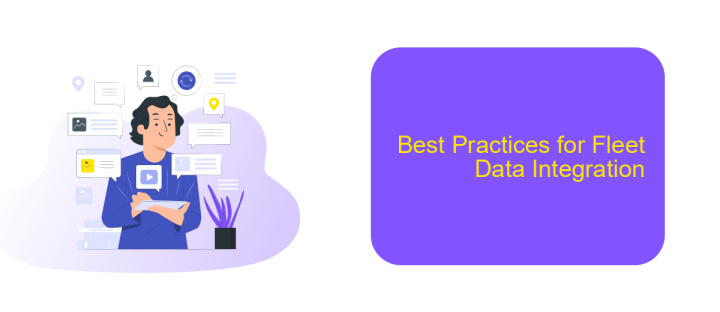Fleet Data Integration
Fleet Data Integration is revolutionizing the way fleet managers oversee and maintain their vehicles. By seamlessly connecting various data sources, such as GPS tracking, fuel consumption, and maintenance records, this technology provides a comprehensive view of fleet operations. The result is enhanced efficiency, reduced operational costs, and improved decision-making capabilities, making it an indispensable tool in modern fleet management.
Introduction
Fleet data integration is a critical component for modern fleet management systems, enabling seamless communication and data exchange between various platforms and applications. This process not only improves operational efficiency but also provides valuable insights for decision-making and strategic planning.
- Enhanced operational efficiency
- Real-time data synchronization
- Improved decision-making capabilities
- Cost reduction and resource optimization
Utilizing services like ApiX-Drive can significantly simplify the integration process. ApiX-Drive offers a user-friendly interface and robust features that facilitate the connection of different systems without requiring extensive technical knowledge. By leveraging such tools, fleet managers can ensure that their data flows smoothly across various platforms, leading to better performance and more informed decisions.
Benefits of Fleet Data Integration

Fleet data integration offers numerous benefits, significantly enhancing the efficiency and effectiveness of fleet management. By consolidating data from various sources, fleet managers can gain a comprehensive view of their operations, allowing for better decision-making and strategic planning. This integration helps in monitoring vehicle performance, driver behavior, and fuel consumption in real-time, leading to reduced operational costs and improved safety standards. Additionally, predictive maintenance becomes more feasible, as data analytics can identify potential issues before they escalate, minimizing downtime and extending the lifespan of vehicles.
Moreover, fleet data integration facilitates seamless communication and coordination across different departments and stakeholders. Utilizing services like ApiX-Drive, businesses can automate the data integration process, ensuring that all relevant information is up-to-date and easily accessible. This reduces the administrative burden and minimizes the risk of human error. ApiX-Drive's user-friendly interface and robust features make it an ideal solution for integrating various data sources, enabling fleet managers to focus on core activities and strategic initiatives. Ultimately, fleet data integration leads to a more streamlined, cost-effective, and responsive fleet management system.
Challenges of Fleet Data Integration

Integrating fleet data poses several challenges that can hinder the efficiency and effectiveness of fleet management. These challenges arise due to the complexity and diversity of data sources, as well as the need for real-time processing and analysis.
- Data Compatibility: Different systems and devices often use various data formats, making it difficult to standardize and integrate the information.
- Real-Time Data Processing: Fleet management requires real-time data to make quick decisions, but processing large volumes of data in real time can be resource-intensive.
- Security and Privacy: Ensuring the security and privacy of fleet data is crucial, especially when dealing with sensitive information.
- Scalability: As fleets grow, the data integration system must be scalable to handle increasing volumes of data without compromising performance.
To address these challenges, services like ApiX-Drive can be highly beneficial. ApiX-Drive offers seamless integration of various data sources, ensuring compatibility and real-time processing. Additionally, it provides robust security measures and scalable solutions to accommodate growing fleets. By leveraging such services, fleet managers can overcome integration hurdles and enhance overall operational efficiency.
Best Practices for Fleet Data Integration

Effective fleet data integration is crucial for optimizing operations and ensuring seamless communication between various systems. To achieve this, it's essential to follow best practices that enhance data accuracy and accessibility.
First, ensure that all data sources are standardized. This involves using consistent formats and units of measurement across all systems. Standardization prevents data discrepancies and simplifies the integration process. Additionally, leverage APIs and integration platforms like ApiX-Drive to automate data synchronization. ApiX-Drive enables effortless connection between disparate systems, reducing manual data entry and minimizing errors.
- Standardize data formats and units of measurement.
- Utilize APIs and integration platforms like ApiX-Drive.
- Implement robust data validation and error-checking mechanisms.
- Regularly update and maintain integration protocols.
- Ensure data security and compliance with relevant regulations.
Lastly, continuous monitoring and optimization are vital. Regularly review integration performance and address any issues promptly. By adhering to these best practices, fleet managers can ensure reliable data flow, leading to more informed decision-making and improved operational efficiency.


Conclusion
Fleet data integration is a crucial aspect of modern fleet management, offering significant improvements in operational efficiency, cost reduction, and data-driven decision-making. By consolidating data from various sources, fleet managers can gain comprehensive insights into vehicle performance, driver behavior, and maintenance needs. This holistic approach enables proactive maintenance, optimized routing, and enhanced safety measures, ultimately increasing the productivity and longevity of the fleet.
Implementing effective fleet data integration can be challenging, but leveraging platforms like ApiX-Drive simplifies the process. ApiX-Drive provides seamless connectivity between disparate systems, ensuring that data flows smoothly and accurately. Its user-friendly interface and robust integration capabilities allow fleet managers to automate data collection and analysis, reducing manual efforts and the potential for errors. By utilizing such advanced tools, companies can stay ahead in a competitive market, ensuring their fleet operations are both efficient and sustainable.
FAQ
What is Fleet Data Integration?
Why is Fleet Data Integration important?
What types of data can be integrated in a fleet management system?
How can I automate Fleet Data Integration?
What are the challenges of Fleet Data Integration?
Do you want to achieve your goals in business, career and life faster and better? Do it with ApiX-Drive – a tool that will remove a significant part of the routine from workflows and free up additional time to achieve your goals. Test the capabilities of Apix-Drive for free – see for yourself the effectiveness of the tool.

